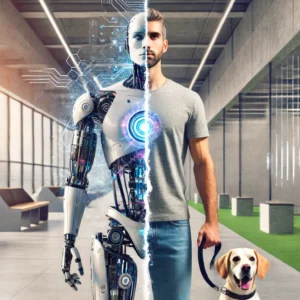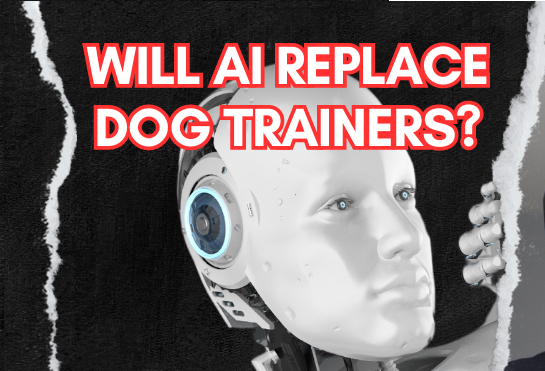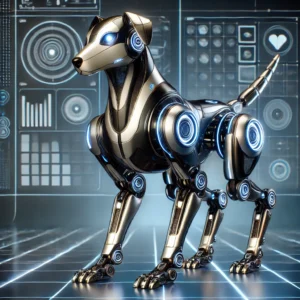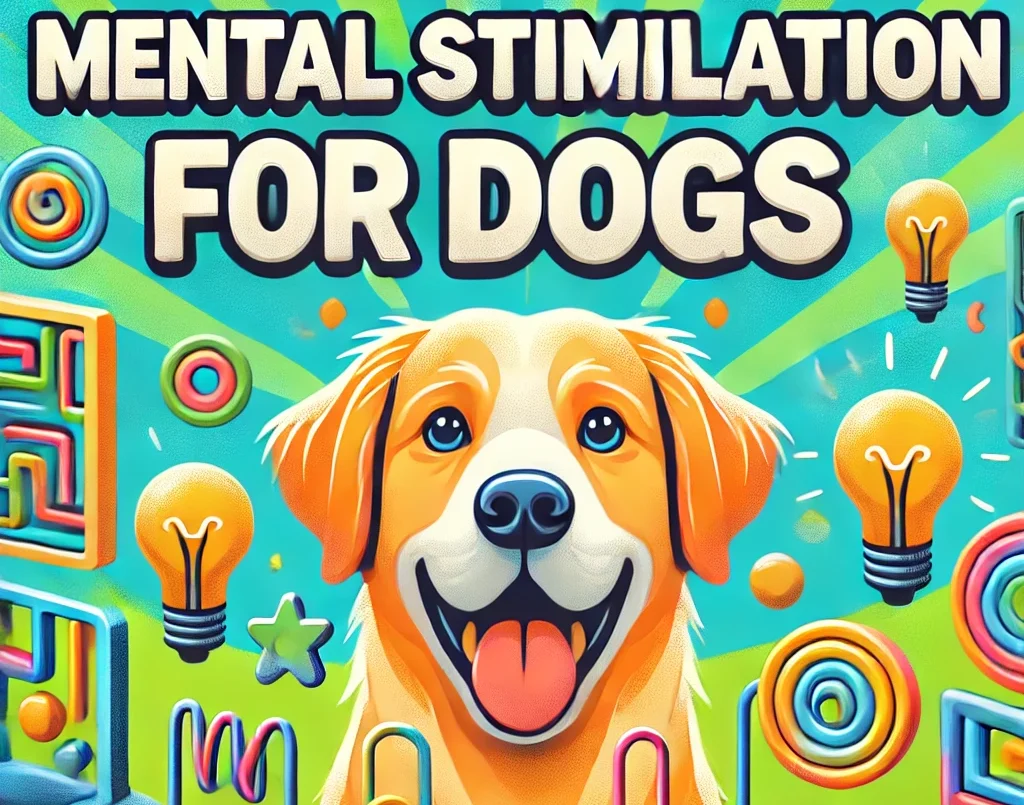Will AI Replace Dog Trainers?
Will an AI powered robot arrive at your door and train your dog for you? Will AI animal trainers be a big thing over the next couple of years? Dog trainer’s getting replaced by AI is a question that is being asked by both dog owners and dog trainers alike.

- AI is replacing White Collar jobs faster than Blue Collar
- Will AI fully replace dog trainers jobs?
Artificial Intelligence (AI) is a rapidly evolving landscape and questions abound about which professions will be affected next. White-collar jobs, such as those in finance, law, and journalism are already experiencing significant impacts due to AI. Blue-collar jobs, including dog training, seem less vulnerable at this time. However, with continued advancements in AI technology, it's worth exploring if we think that AI could replace dog trainers. Or at least revolutionize the field of animal training. Within this article, we'll delve into this intriguing question. Examining the current state of AI in dog training and the overall complexities of training dogs. Do we think AI could ever fully replace the nuanced work of human trainers? Read on to find out!
AI's Impact: White Collar vs. Blue Collar Jobs
AI has seen a rapid integration into various sectors. These have predominantly been white-collar jobs. In these jobs tasks are often routine and data-driven making automation easy. Think of jobs like financial analysts, paralegals, and medical professionals. All of these industries have seen AI tools automate substantial portions of their work. These AI tools excel at processing large amounts of information. They can then quickly and accurately make decisions about that information. This makes AI ideal for jobs that involve data analysis, pattern recognition, and decision-making.
Jobs that AI is Impacting:
- Financial Analysts
- Paralegals
- Medical Professionals
In contrast, blue-collar jobs, particularly those involving physical tasks, human interaction, and nuanced decision-making, have been slower to see AI's direct impact. Dog training is a prime example of a profession where the complexity of tasks and the need for personalized interaction makes AI replacement more challenging. Training a dog involves understanding not just the behavior of the dog but also the dynamics between the dog and its owner, the environment, and the specific challenges each dog presents.
AI as a Knowledge Base for Dog Training
One area where AI is making strides in dog training is as a knowledge base. AI-powered apps and platforms can offer tips, tutorials, and even behavior analysis based on algorithms trained on vast amounts of data. These tools can provide general advice, help owners understand basic training principles, and offer solutions to common behavioral issues.
We see this being a huge win for dog owners that are looking to teach their dog obedience commands and tricks. Utilizing the AI knowledge base on dog training can allow owners access to a wealth of information to teach their pups commands they might have never thought possible. AI can also remind owners of training schedules, track progress, and offer step-by-step guides to ensure consistency in training. These applications make dog training more accessible to the general public, especially for those who cannot afford a professional trainer.
Things AI Can Do Today to Replace Dog Trainers:
- Build a knowledge base of dog training topics
- Create Schedules for training
- Track Progress
One area we think that AI will continue to struggle though is analyzing and making suggestions for behavioral training. While AI can analyze video footage of a dog’s behavior and suggest training techniques to correct unwanted actions, not having full access to the knowledge that can be gained by having access to the dog themselves or by being able to ask the dog owners the right questions, leaves the chances of errors in implementing the proper strategy to be likely.
The Bias Toward Positive-Only Training in AI
A significant concern we have at Suburban K9 with AI-driven dog training tools is their bias toward positive-only training methods. Our review of AI systems shows that they seem to heavily suggest positive-only training practice, while downplaying or outright ignoring the role of a more balanced approach. This bias can create a gap in effective training, especially for dogs that require a more balanced approach.
Watch our Balanced Dog Training Podcast where Suburban K9 owner Matt Covey dives into AI’s answers to many common dog training questions. It is very interesting to see how questions are answered.
Balanced trainers know that while rewarding desired behaviors is crucial, addressing undesirable behaviors through appropriate corrections is equally important. This approach mimics natural training processes seen in animal behavior, where both rewards and corrections are used to teach and enforce behavioral norms. AI, however, struggles to replicate this balance. The ethical implications of implementing corrections through AI without human oversight are complex, and the technology to execute such nuanced training is not yet developed.
Whether this bias is intentional or simply a bias caused by the information available on the internet isn’t truly known. It will be interesting to see how this continues to play out as more AI models are created and trained in different dog training methods.
The Complexity of Training Dogs: Limitations of AI
We believe that training a dog is a complex process that requires a deep understanding of canine behavior and psychology. Understanding these things allows trainers to make unique decisions about the needs of each individual dog. This involves interpreting subtle cues from the dog and its owner. Using those queues the trainer can adapt their training strategies in real-time. As an example, dogs might react differently to training techniques based on breed, age, past experiences, and even the trainer's demeanor. This can have a major impact on the outcoming of the training program.
An AI robot designed to train dogs would need to be incredibly sophisticated to handle these variables. It would need to process and interpret a wide range of physical signals from the dog, adjust its approach dynamically, and build a rapport with both the dog and its owner. While AI can excel in data processing, the emotional intelligence, intuition, and adaptability required for effective dog training are traits that current AI systems lack.
Furthermore, the physical interaction involved in dog training, such as leash handling, administering corrections, and ensuring safety during sessions, would require a robot capable of complex motor functions and delicate touch—another area where AI and robotics are still catching up.
Will AI Dogs Replace Living Dogs?
As AI continues to evolve over time, fascinating questions emerges. Could AI dogs replace living dogs? AI-powered robotic dogs are already a reality. Companies like Boston Dynamics and Sony have developed robots that can mimic the movements and behaviors of real life dog. These AI dogs can fetch, follow commands, and even display what seems like affection.
However, while AI dogs might appeal to those who cannot own a pet due to allergies, housing restrictions, or other limitations, they are unlikely to replace the companionship and emotional bond that living dogs provide. Real dogs have truly evolved as “man’s best friend” over hundreds of years and offer a level of unpredictability, warmth, and genuine affection that AI will find difficult to replicate. The joy of a wagging tail, the warmth of a snuggle, and the deep connection formed through shared experiences are irreplaceable by machines.
- Go2 Air model is a great option for beginners that are just starting out with AI.
- The Go2 Pro offers more advanced features that is great for someone with more experience playing with AI and technology.
- Smart-phone AI App Integration that allows for full dog unit control
- Improved Battery for Longer Battery Life.
Training AI Dogs: A New Frontier?
If AI dogs become more common, a new frontier in dog training could emerge—training AI dogs. These would not be traditional training sessions but rather programming and customizing the behavior of robotic dogs to meet the needs and preferences of their owners. This could involve adjusting responsiveness, activity levels, and interaction patterns based on the owner's lifestyle.
AI simulations of dogs are gaining popularity in digital environments like The Sandbox as well as other virtual worlds. In these simulation games (sims), users interact with virtual dogs. These virtual dogs exhibit life-like behaviors. Allowing game players to train, play with, and care for their digital companions. Virtual simulations provide a unique opportunity for people to experience the joy of dog ownership without the responsibilities of a real pet. While these AI dogs can simulate basic behaviors, they are still limited by the parameters of the game. This means that they tend to lack the unpredictability and personality of real dogs.
The "training" that is being done with dogs in this virtual world tends to be more akin to software programming or game play than the nuanced, hands-on training required for living dogs. It means that we would be shifting the role of a dog trainer to a computer programmer. We think this further highlights the irreplaceability of human trainers and real dogs.
Conclusion: The Future of Dog Training and AI
While AI is undoubtedly making progress and helping us in many aspects of our lives, replacing dog trainers seems unlikely. At least in the next 10 years. The complexity of training dogs, the need for balanced approaches, and the ability to quickly adapt to subtle cues are all areas where AI currently falls short. AI will however continue to play a supportive role, offering knowledge bases and tools that can complement the work of human trainers.
The possibility of AI dogs adds another layer to the discussion, presenting a future where humans might choose between living companions and robotic ones. Yet, for those who value the deep, genuine connection that only a living dog can offer, the role of human dog trainers will remain essential. AI can enhance the training process, but it cannot replace the unique bond between dogs and their trainers—a bond built on understanding, trust, and mutual respect.
- If you enjoyed this article on if AI will replace dog trainers you might enjoy this book on AI and the future of jobs.
- Written by Ji Anon it explores automation and AI in business and the effects that it will have on individual jobs.
The article above contains Affiliate Links from Amazon and other companies. If you visit their site and buy the product, we will get a small commission. Please know that we only recommend products we love and would never recommend a product we think is less than great. We look at and try hundreds of products before we ever recommend them to our clients!







